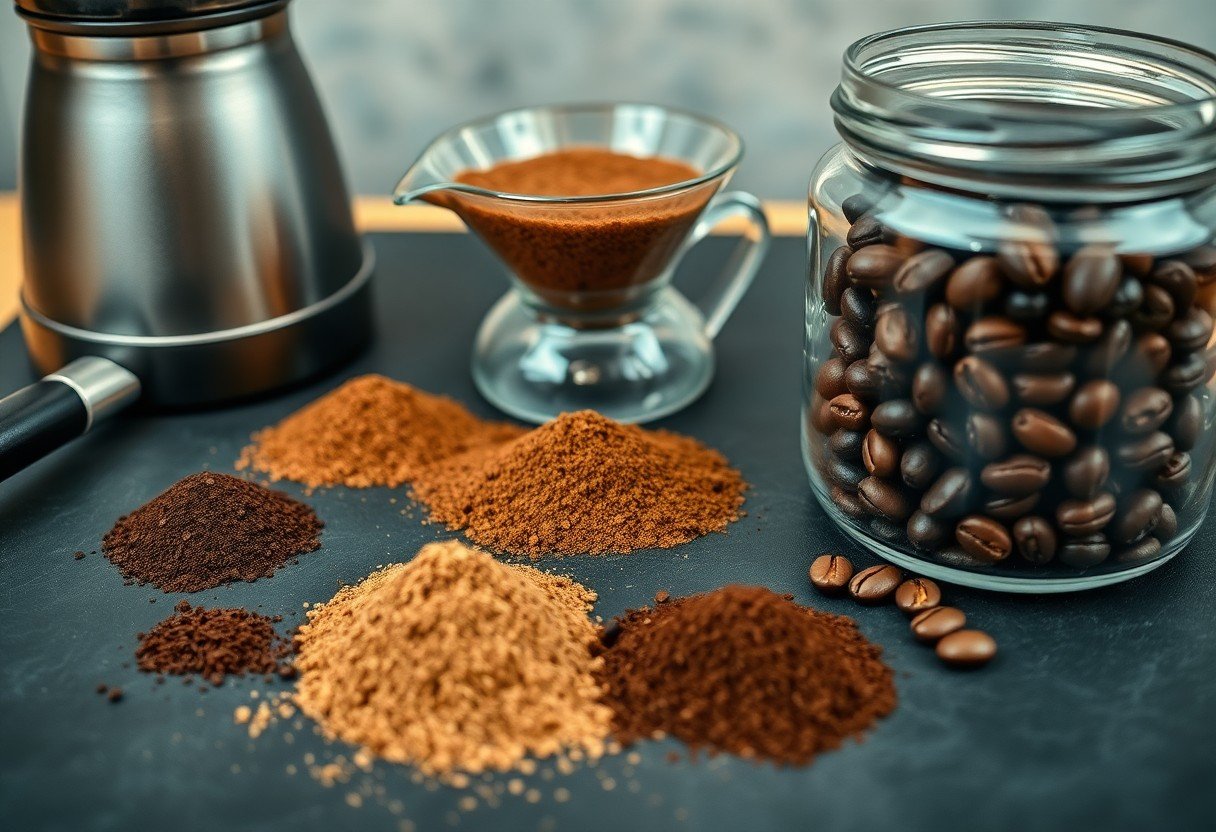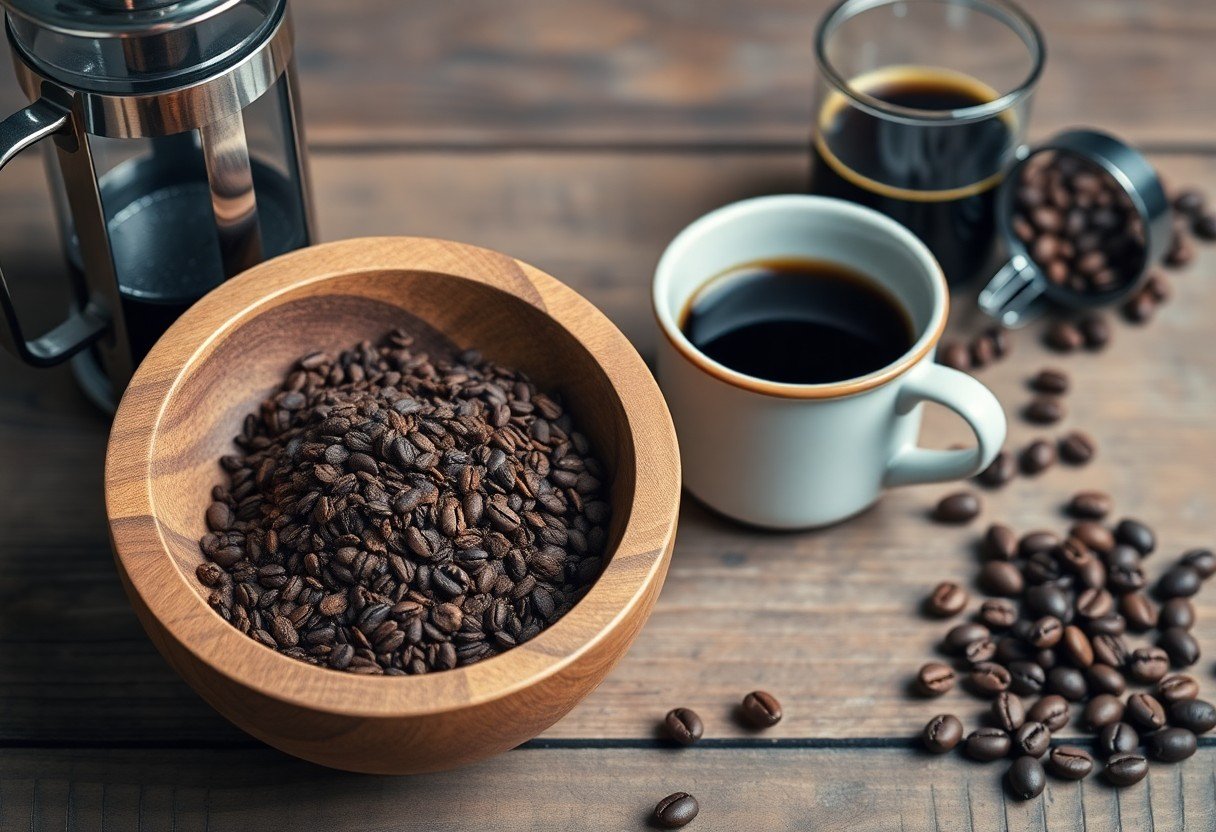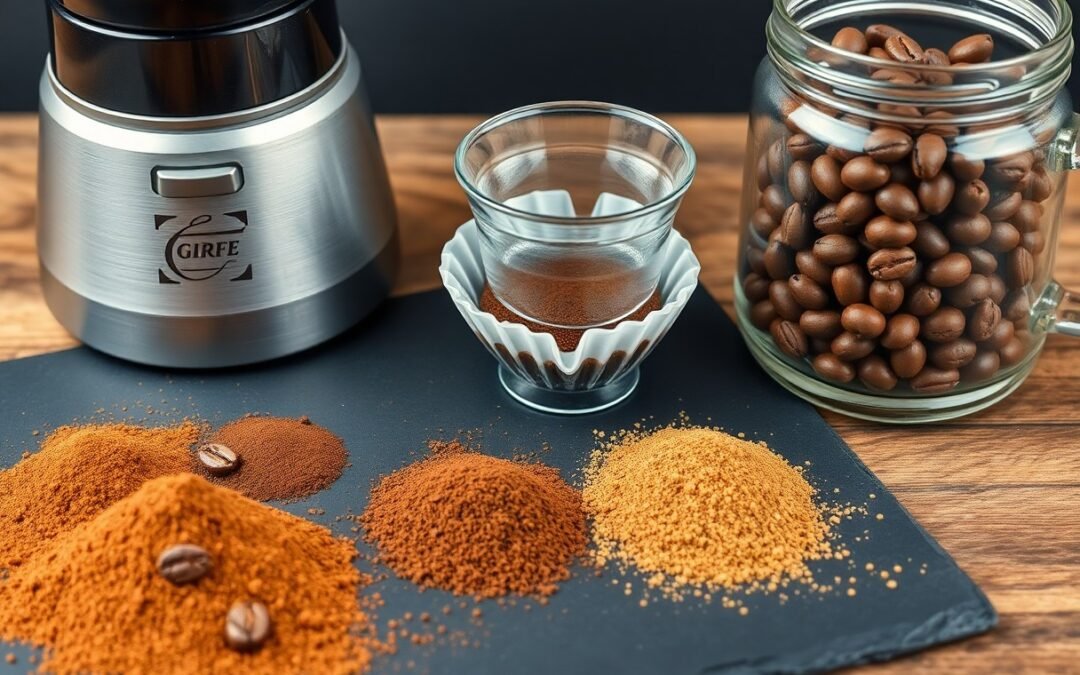It’s imperative to understand how artisanal grinds can elevate your home brewing experience. By selecting high-quality, freshly ground coffee, you tap into a rich tapestry of flavors and aromas that enhance the sensory journey of each cup. This process not only transforms your coffee ritual into an art form but also allows you to connect deeply with the origins and unique characteristics of your beans. As you explore the nuances of different grinds, you’ll discover how they significantly influence extraction and ultimately, the poetry of your home brewing process.
The Alchemy of Grind Size: Transforming Coffee’s Flavor Profile
Your choice of grind size acts as a hidden magician in the coffee brewing process, transforming the beans into a canvas of flavors waiting to be unveiled. Each size adjusts the extraction rate and interaction between water and coffee, allowing you to sculpt the final brew to your liking. Fine grounds tend to produce a richer, bolder flavor, while coarser grinds tend to create a more delicate, nuanced cup. Adjusting grind size not only changes the taste but also alters the entire experience of your morning ritual.
The Science of Extraction: How Grind Size Affects Taste
Exploring Coffee’s Flavor Spectrum: From Fruity Brightness to Earthy Depths
Understanding how grind size interacts with coffee’s flavor spectrum opens doors to a world of taste exploration. A light roast, with its inherent brightness and fruity notes, can shine through when brewed with a medium grind, allowing the nuanced acidity to resonate. On the other hand, a dark roast, often characterized by its earthy depth, can reveal its full-bodied richness with a coarser grind, perfect for immersion methods like the French press. This dialogue between grind size and flavor not only enhances your brewing skills but also deepens your appreciation for the intricate artistry of coffee itself.

The Art of Precision: Tailoring Grinds to Brewing Methods
Mastering the grind size allows you to unlock the full essence of your coffee, aligning each brew with its optimal extraction. Whether you’re using a French press, espresso machine, or pour-over, adjusting your grind size prevents common pitfalls like over-extraction or under-extraction, thus ensuring that each cup reflects your unique taste preferences. By precisely tailoring grinds to methods, you elevate your home brewing experience and enhance the intricate dance of flavors within each bean.
Matching Grind Size with Brewing Techniques
Each brewing method demands a specific grind size to achieve its intended profile. A coarse grind, ideal for French presses, promotes longer extraction times, yielding bold flavors without bitterness. Conversely, a fine grind is important for espresso, allowing for quick extraction under pressure, resulting in rich, concentrated shots. Understanding these relationships empowers you to brew with intention and clarity.
The Role of Freshness in Enhancing the Brewing Experience
The freshness of your coffee beans plays a pivotal role in your brewing journey. Beans that are ground immediately before brewing preserve important oils and volatile compounds, maximizing flavor. Coffee starts to lose its vibrancy within minutes of grinding, which can significantly alter your cup. Prioritizing fresh beans ensures that every sip captures the full spectrum of aromas and tastes.
Freshly ground coffee beans not only enhance flavor but also amplify the aromatic experience of each brew. As you grind coffee moments before brewing, you unlock important oils and gases that would otherwise dissipate. Studies show that coffee reaches its peak flavor within 15 minutes of grinding, enabling a bright, nuanced cup with vivid notes. Additionally, the vivid sensory experience—intense scent, vibrant color—creates an engaging ritual, transforming brewing into an art form that reflects your personal taste. Embracing freshness elevates your coffee making from a routine to a celebration of flavor and craftsmanship.
Craftsmanship in the Grind: Choosing the Right Equipment
Investing in the right grinding equipment significantly enhances the brewing experience. Each tool contributes uniquely to achieving the desired grind size, impacting flavor extraction and overall quality. Manual and electric grinders present distinct advantages and drawbacks, allowing you to tailor your choice based on convenience, control, and aesthetic preferences.
Comparing Manual vs. Electric Grinders: Pros and Cons
Pros and Cons
| Manual Grinders | Electric Grinders |
|---|---|
| Cost-effective | Fast grinding speed |
| Quiet operation | Consistent grind size |
| Portable and easy to store | Less physical effort required |
| Greater control over grind size | More options for settings and features |
| Minimal maintenance | May generate heat affecting flavor |
| Requires time and attention | More expensive upfront cost |
| Handcrafted experience | Limited portability |
| Doesn’t require electricity | Can be noisy |
The Importance of Burr vs. Blade Grinding in Flavor Delivery
Burr grinders are known for their ability to create uniform particle size, allowing for precise extraction during brewing. This consistency is key to enhancing flavors, as similar-sized grounds interact evenly with water. Blade grinders, on the other hand, often produce irregular sizes, leading to over-extraction or under-extraction of flavors, which can result in a less satisfying cup. Understanding these differences empowers you to select the better option for your brewing preference.
Burr grinders use two revolving abrasive surfaces to crush the coffee beans, resulting in a uniform grind for a consistent flavor profile. In contrast, blade grinders chop beans unevenly, often creating fine dust along with larger pieces that can negatively impact your brew. Research indicates that coffee brewed from burr ground beans tends to have a richer taste and greater complexity compared to blade ground coffee. This level of precision in grind quality not only elevates your brewing process but also enhances your overall coffee experience at home.

Elevating the Sensory Experience: Beyond Just Taste
Engaging all your senses transforms home brewing into an art form. While taste is the focal point, aroma and texture significantly shape your overall experience. The rich, earthy fragrance of freshly ground coffee evokes feelings of warmth and comfort, creating an atmosphere of anticipation. Similarly, the tactile sensation of different brew methods — the smoothness of a pour-over versus the robustness of a French press — invites you to appreciate the nuances beyond mere flavor, encouraging a multi-layered exploration of your morning ritual.
Engaging the Senses: Aroma and Texture in Brewing
The aroma released during grinding encapsulates the essence of the coffee bean, awakening your senses long before the brew reaches your lips. Each grind unleashes volatile compounds, releasing a bouquet that ranges from floral to nutty. Texture plays a substantial role as well; whether it’s a coarse grind giving way to a rich body or a fine grind leading to a silky, smooth cup, your choice enhances both the drinking experience and the complex interplay of flavors.
The Ritual of Grinding: Mindfulness and Connection in Home Brewing
Turning the act of grinding into a mindful practice cultivates a deeper bond with your coffee. Each grind offers a pause, an opportunity to engage in the present moment. You can feel the weight of the beans in your hand, the grinding motion grounding you in the process. This intimate connection transforms an ordinary routine into a meaningful ritual, enriching your brewing experience and fostering appreciation for each step from bean to cup.
The importance of ritual in grinding goes beyond simply preparing coffee; it fosters a moment of reflection and gratitude. Each grind serves as a reminder of the journey from farm to kitchen, connecting you with the farmers who nurtured those beans and the environment that produced them. Taking time to appreciate the nuances of each step not only enhances your coffee but also instills a sense of mindfulness that transcends your brewing routine. Engaging fully in these moments allows you to cultivate a deeper appreciation for the artistry of coffee brewing at home.
Community and Culture: The Rise of Artisanal Coffee Movements
The resurgence of artisanal coffee movements reflects a deeper connection to community, sustainability, and the craft of brewing. As you explore local roasters and artisan cafés, you’ll discover a rich tapestry of cultural narratives distilled through each cup. This movement emphasizes transparency in sourcing, valuing the hands and stories behind your coffee, fostering a sense of belonging that transforms coffee drinking into communal experiences.
Understanding the Cultural Significance of Handcrafted Coffee
Handcrafted coffee has evolved into a symbol of quality and intention, bridging the gap between producer and consumer. You embrace not just a beverage but a cultural artifact—one that highlights the labor of farmers, the skill of roasters, and your own personal touch in brewing. This connection instills a greater appreciation for the craft, transforming routine coffee consumption into a mindful ritual that celebrates diversity and heritage.
Fostering Community through Shared Brewing Experiences
Shared brewing experiences cultivate bonds among coffee enthusiasts, transforming solitary rituals into communal events. You find joy in gathering friends or joining local brewing clubs, where exchanging techniques and tasting notes enhances your appreciation of the craft. These interactions spark creativity, inspiring you to experiment with different brewing methods while deepening relationships over shared flavors and stories.
Gathering around coffee brewing fosters memorable connections that extend beyond taste. Hosting a brew session with friends allows for lively discussions about flavor profiles or roast origins, creating an informal classroom atmosphere. Events such as cuppings or pour-over contests not only elevate your skills but also encourage social interactions. In these moments, you aren’t just sampling coffee; you’re participating in a shared culture, cultivating a community that thrives on collaboration, creativity, and curiosity. These experiences make you an integral part of a larger narrative that celebrates the art of coffee and strengthens the fabric of your local community.
Summing up
Conclusively, artisanal grinds elevate your home brewing experience by enhancing flavor profiles and aroma, allowing you to appreciate the distinct character of each coffee bean. The meticulous process of selecting and grinding coffee lets you engage more deeply with your brew, transforming it into a sensory ritual. By understanding the impact of grind size on extraction, you can refine your methods, bringing out the best in your chosen beans. Ultimately, this personalized approach not only amplifies the poetics of brewing but also enriches your overall enjoyment of coffee.
FAQ
Q: What are artisanal grinds?
A: Artisanal grinds refer to coffee or tea grounds that are carefully crafted using traditional methods or specialized equipment. These grinds are often sourced from high-quality beans or leaves, emphasizing flavor profiles and unique characteristics that enhance the brewing experience.
Q: How do artisanal grinds affect the flavor of my brew?
A: Artisanal grinds can significantly impact flavor by achieving optimal extraction levels. Their specific coarseness or fineness allows for better flavor release, enhancing the overall taste and aroma of the brewed beverage.
Q: Can artisanal grinds make brewing easier at home?
A: Yes, artisanal grinds streamline the brewing process by providing consistency in particle size. This uniformity allows for more predictable brewing outcomes, making it simpler to achieve desired flavor profiles without trial and error.
Q: What brewing methods work best with artisanal grinds?
A: Artisanal grinds are versatile and can be used in various brewing methods, including pour-over, French press, and espresso. Each method can highlight different aspects of the grind, offering a richer tasting experience.
Q: How can I incorporate artisanal grinds into my daily routine?
A: Incorporating artisanal grinds can be done by selecting high-quality coffees or teas, experimenting with different grinding techniques, and adjusting brewing times. This approach allows for a personalized experience tailored to individual taste preferences.

